Low Maintenance Garden Part 2: Techniques
Carolyn’s Shade Gardens is a retail nursery located in Bryn Mawr, PA, specializing in showy, colorful, and unusual plants for shade. The only plants that we ship are snowdrops and miniature hostas. For catalogues and announcements of events, please send your full name, location, and phone number (for back up use only) to carolyn@carolynsshadegardens.com. Click here to get to the home page of our website for catalogues and information about our nursery and to subscribe to our blog.
.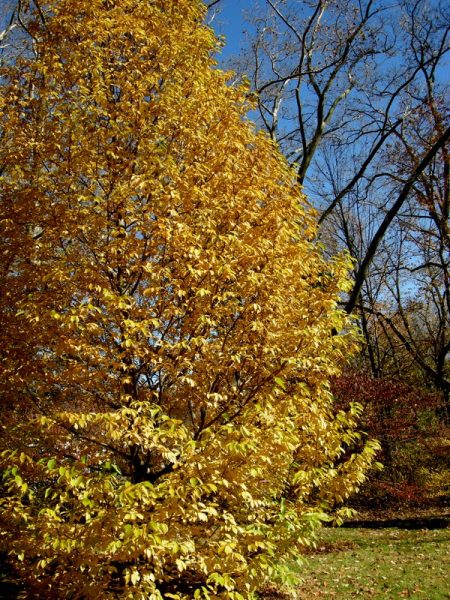 ‘Wada’s Memory’ magnolia provides plenty of leaves for Michael’s leaf grinding efforts plus some gorgeous fall color.
‘Wada’s Memory’ magnolia provides plenty of leaves for Michael’s leaf grinding efforts plus some gorgeous fall color.
My husband Michael and I have spent 30 years perfecting our gardening techniques at Carolyn’s Shade Gardens, and we are always happy to pass on what we have learned to our nursery customers. In spring 2012, Michael developed a series of seminars to demonstrate our methods to our customers right here at the nursery. This post is Part 2 of a two part series explaining what goes on at Michael’s seminars. Part 1 detailed the tools that we recommend to make garden maintenance easy. You can read it by clicking here.
.
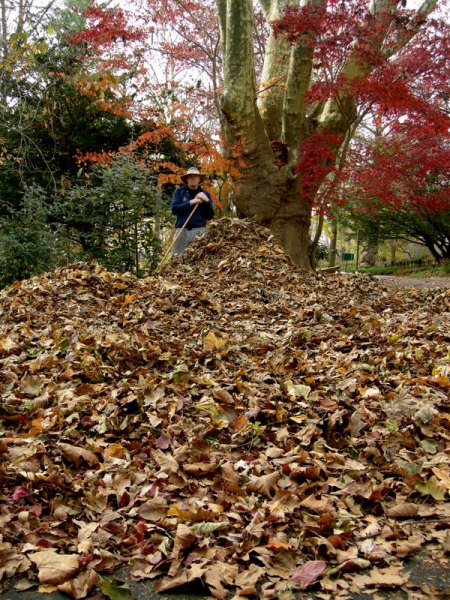 Michael with a typical pile of leaves ready for grinding into mulch.
Michael with a typical pile of leaves ready for grinding into mulch.
We believe that the most valuable asset on our property is the leaves that fall from our trees. Leaves are what nature provides for free to protect and improve your soil. Removing and disposing of your leaves outside your own property is the worst thing that you can do to your garden. During his seminar, Michael demonstrates how we handle the massive quantity of leaves that fall from our 35 plus large deciduous trees. Basically we leave them in place to decompose on their own, grind them on the lawn to help it grow, and grind them into mulch for our garden beds.
.
 Michael demonstrates leaf grinding to seminar attendees.
Michael demonstrates leaf grinding to seminar attendees.
For a step-by-step guide to grinding your leaves to use for mulch, please read my post Your Most Precious Garden Resource by clicking here. For a video by Scotts Lawn Care showing how to grind leaves on your lawn, click here. A recent Michigan State University study has shown that grinding up to 18″ of leaves on your lawn and leaving them there is beneficial to your lawn. For more information on how we handle leaves in our beds in the fall, click here.
.
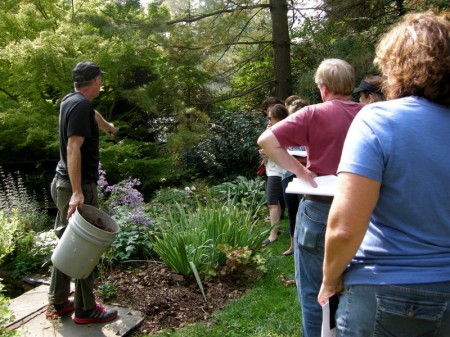 Michael demonstrates how he uses the ground leaves for mulch in our gardens.
Michael demonstrates how he uses the ground leaves for mulch in our gardens.
.
Our other secret weapon is compost, which we make ourselves and also get from the township. No bed is created and no plant is planted without adding a large amount of this “black gold”. Michael shows seminar attendees what good compost should look like and demonstrates how we go about composting. For more information on how we use compost in our garden, read my post Powered by Compost by clicking here.
.
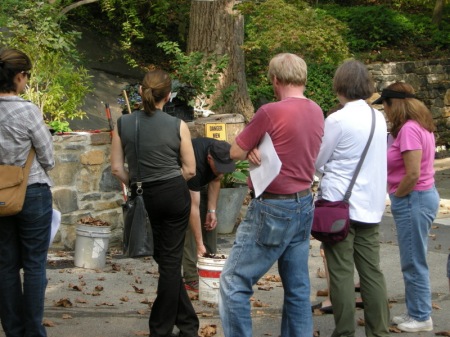 During the tool session at the beginning of the seminar, Michael talks about what an important tool compost is.
During the tool session at the beginning of the seminar, Michael talks about what an important tool compost is.
.
 Every seminar includes a trip to our compost area and a demonstration of composting techniques.
Every seminar includes a trip to our compost area and a demonstration of composting techniques.
Many other important gardening jobs are explained in detail with live demonstrations…..
.
 Planting a perennial using a shovel or an auger attachment to a drill.
Planting a perennial using a shovel or an auger attachment to a drill.
.
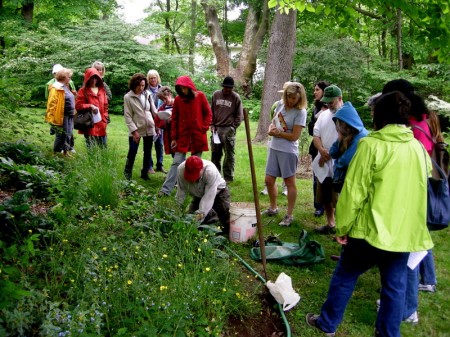 Edging beds to keep out weeds and present a manicured look.
Edging beds to keep out weeds and present a manicured look.
.
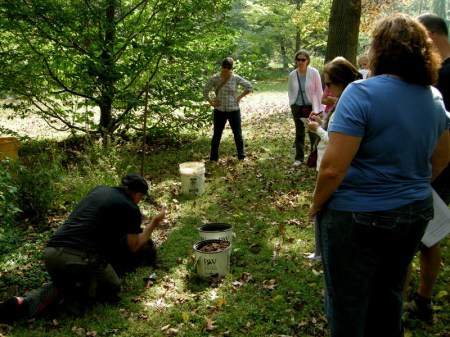 Planting a shrub, here Michael shows how it is important to loosen the roots on the outside of the rootball.
Planting a shrub, here Michael shows how it is important to loosen the roots on the outside of the rootball.
.
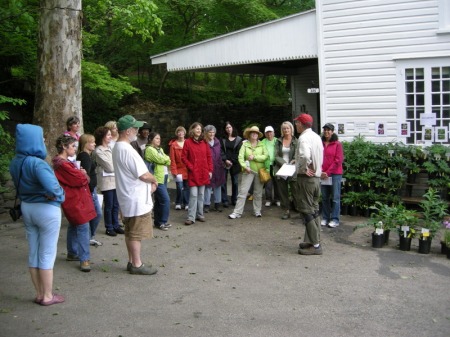 Every session ends with a question and answer period during which attendees can ask about any gardening task that interests them.
Every session ends with a question and answer period during which attendees can ask about any gardening task that interests them.
.
These are just some of the topics covered in a typical seminar. Other subjects include deer management, invasive plant removal, winter interest, container planting, and many more.
Carolyn
.
Carolyn’s Shade Gardens is a local retail nursery in Bryn Mawr, Pennsylvania, U.S., zone 6b. The only plants that we mail order are snowdrops and miniature hostas and only within the US.
If you are within visiting distance and would like to receive catalogues and information about customer events, please send your full name and phone number to carolynsshadegardens@verizon.net. Subscribing to my blog does not sign you up to receive this information.
Nursery Happenings: Carolyn’s Shade Gardens is closed for the winter. Please visit my Etsy Shop to purchase photo note cards suitable for all occasions by clicking here. Look for the 2014 Snowdrop Catalogue in early January.
Facebook: Carolyn’s Shade Gardens has a Facebook Page where I post single photos, garden tips, and other information that doesn’t fit into a blog post. You can look at my Facebook page here or click the Like button on my right sidebar here.
Notes: Every word that appears in orange on my blog is a link that you can click for more information. If you want to return to my blog’s homepage to access the sidebar information (catalogues, previous articles, etc.) or to subscribe to my blog, just click here.
December 1, 2013 at 9:57 pm
I have used a mulching mower from the time they came out and love what it does to replenish the soil and fertilize plants (grass too). I alternate leaving in place with bagging to add to the compost because “brown and green” make the best and fastest producing compost. I do get additional compost and manure (zebra and deer) from the farm too. I am sure your customers find the demonstrations valuable.
December 2, 2013 at 6:32 pm
Donna, Zebra manure must be the magic ingredient that makes your garden so beautiful. Carolyn
December 2, 2013 at 7:41 pm
It is just free. Being a growers’ nursery, they compost all the animals’ manure and it is a great source of nutrients, the same or better than cow manure I am assuming. In PA where I had horses, we used that mixed with the straw to compost down.
December 1, 2013 at 10:03 pm
It must be such a rewarding experience to teach people valuable lessons that will last a life time and odds are they’ll be spreading the word of composting to many others, Good work, Carolyn.
December 2, 2013 at 6:35 pm
Patrick, I feel like I am doing my part to help the environment. We have gotten pretty far away from what nature intended with our gardening methods in the US, and I hope to train people back to the “old ways”. Carolyn
December 1, 2013 at 11:22 pm
I am always amazed when I see people diligently rake their leaves, only to put them in big plastic bags for trash pick-up. The next spring those same people spend good money on mulch in plastic bags! I do wish we had a leaf shredder, but our leaves break down pretty quickly, whether left in natural areas or put into the compost heap.
December 2, 2013 at 6:36 pm
Deb, You don’t need a leaf shredder, just run over the leaves with a lawnmower. Yes, the get rid of the mulch that nature provides and then buy mulch system makes little sense. Carolyn
December 1, 2013 at 11:40 pm
You and Michael provide a valuable service Carolyn. I have been using a John Deere tractor with a mulcher deck for years…. most folks thought I was crazy but it really does a good job taking care of grass clippings and turns the leaves into minute segments once the grass mulching season has past. My biggest compost problem is that I am always adding sods to my pile that is presently over 20 feet long by about 15′ wide and seven feet tall. Despite all the other materials that I add from the gardens, it remains a heavier loamy material than I’d like, but is very rich indeed. I turn it with a full size bucket loader tractor from time to time. This spring I’ll be putting a lot of it to use as I develop raised planting areas for conifers…. I am still frustrated over how much amending and with what, I should do to meet the conifer’s need for good drainage… I’ve been known to overdo in this regard! Larry
December 2, 2013 at 6:40 pm
Larry, And I thought we were composting in a big way! We use the old manure pit for our carriage house which is 10′ by 10′ by 10′, all manual though. Carolyn
December 2, 2013 at 3:35 am
You’ve given me some ideas for a small gardening group here. I think some practical hands on experience would be really useful. In the UK they always say leaves need to be composted for 3 years, your method (and I’ve seen it in other blogs too) of griding the leaves seems such a sensible idea. I leave fallen leaves on the borders but remove them from paths to add to compost.
December 2, 2013 at 6:46 pm
Christina, the ground leaves break down to compost in the beds by next fall so we are mulching and composting at the same time. I am not sure where the three years comes from but that is not my expeience. I leave the leaves in most beds and only remove them in the more refined areas. Carolyn
December 2, 2013 at 8:59 am
Wonderful! I collect all the leaves my neighbor’s rake out to the curb.
December 2, 2013 at 7:47 pm
Arthur, We lost a big tree above our drive last August so now Michael collects and grinds some of our neighbors leaves in addition to ours. Carolyn
December 2, 2013 at 7:49 pm
I love the free mulch! Of course, my neighbors will buy compost and mulch in the spring! I make my own from their leaves! 🙂
December 2, 2013 at 9:54 pm
I’m glad to know I’m doing another thing right. I basically let the leaves stay where they fall except on the lawn. I rake most of the ones from the lawn onto tarps and spread them on the forest floor. They create a gentle carpet that slowly decomposes. The ones on the garden beds provide a warm blanket for my perennials. In the springtime, I rake some of them off for the compost pile, but leave most of them to decompose in place. The Oak leaves take a while to decompose, but they are very good mulch for the perennials. The soil under them is thick and rich and fertile. Thanks for the full descriptions and advice, Carolyn!
December 3, 2013 at 8:54 am
Beth, I think people get tired of us harping on about the leaves but they are so important for the garden. Carolyn
December 3, 2013 at 4:26 am
Yes, we collect all our leaves, they’re invaluable at planting time, along with the compost we make. No matter how much leaf mould and compost we make, there never seems to be enough!
December 3, 2013 at 8:19 am
Pauline, That’s the way it is here. We are lucky that we can always get as much compost as we want from the township/local government, but we always run out of ground leaves the following spring and wish we had more. Carolyn
December 3, 2013 at 3:36 pm
Great tips Carolyn. We compost the leaves at the back of the garden but end up sending the ones by the street to be picked up by the city. Generally I keep the leaves that fall on the beds but remove those on the lawn.
December 3, 2013 at 5:14 pm
Patty, Just mow the leaves on the lawn, it’s so much easier! Carolyn
December 5, 2013 at 8:38 am
Could not agree more about the value of recycling leaves into compost. Nothing you can buy really beats the natural approach.
December 5, 2013 at 9:52 am
Ben, glad you are composting in the UK too. Carolyn
December 5, 2013 at 2:44 pm
Everybody should read this post. So many people still think of fallen leaves as a nuisance. I think they would change their mind if they saw your beautiful garden. I cut my leaves up with my hedge scissors. I have a very small garden 🙂
December 5, 2013 at 3:12 pm
Denise, Somehow over the course of the 20th century practices changed from the sustainable methods of giving back to the earth to a consumer approach based largely on chemicals. It will take a total re-education of gardeners to understand that nature really provides what is needed for a healthy garden. Hedge shears are ideal because unlike lawnmowers, they don’t pollute. Carolyn
December 8, 2013 at 10:22 pm
We mow our leaves for use on the veg beds. The other leaves stay on the beds for now…and I have contemplated using edging to keep the grass out of the beds.
December 9, 2013 at 9:13 am
Donna, Edging is a lot of work but it saves much more work in the long run and makes the garden beds look neat and trim even if they are full of weeds :-). Carolyn
December 10, 2013 at 10:43 am
Wonderful advice! You provide a great service for your customers. P. x
December 10, 2013 at 10:54 am
Thanks, Pam, we have been at it a long time so there’s no reason for my customers to reinvent the wheel if we can help. Carolyn